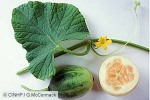Cook Islands Biodiversity Database
Species Page
Cucumis melo var. agrestis
Pātī (MG)Early Melon
Multimedia & Additional Resources
| Type | Description | Download |
| Leaf, flower and fruit | 41KB |
General Information
Cook Islands Distribution
| Southern Group: Present Makatea: - | ||||||||
RR |
MG |
AT |
MK |
MT |
AK |
PL |
TK |
MN |
- |
+ |
- |
- |
- |
- |
- |
- |
- |
| Northern Group: | |||||
TN |
MH |
RK |
PK |
NS |
SW |
- |
- |
- |
- |
- |
- |
Scientific Taxonomy
Cucumis melo var. agrestis
TAXONOMY: PLANTAE; ANTHOPHYTA (=Angiospermae); MAGNOLIOPSIDA (=Dicotyledones); DILLENIIDAE; Violales; CUCURBITACEAE
More Information
SIGNIFICANCE NOTES -
BIODIVERSITY: Nationally endangered (seriously). Comment: Known only from Mangaia.
POSITIVE SIGNIFICANCE: Adornment, Food (Fruit). Comments: Formerly eaten raw in Mangaia, and still used in neck garlands in the Marquesas (GM98).
GENERAL NOTE: Introduced to Polynesia by the early Spanish expeditions, such as Quiros (1606) to the new Hebrides and Boenechea (1772) to Tahiti. The latter introduced maize, wheat, sweet potato, papaya, water melon and other melons - probably including the present species. In ancient times in the Marquesas the fruit was esteemed in neck garlands (hei), and it was a famine food - it was known as katiu inana, ‘Atiu inana and ‘Otio inana.
Vouchers & References
Vouchers:
Mangaia: specimen, Alan Tuara, 1/1994, ID GMcC.
References:
None recorded.
Data Update History (information):
zTX, zB02, zM02, zD02
Web Resources
Citation Information
McCormack, Gerald (2007) Cook Islands Biodiversity Database, Version 2007.2. Cook Islands Natural Heritage Trust, Rarotonga. Online at http://cookislands.bishopmuseum.org. ![]()
Please refer to our use policy.

